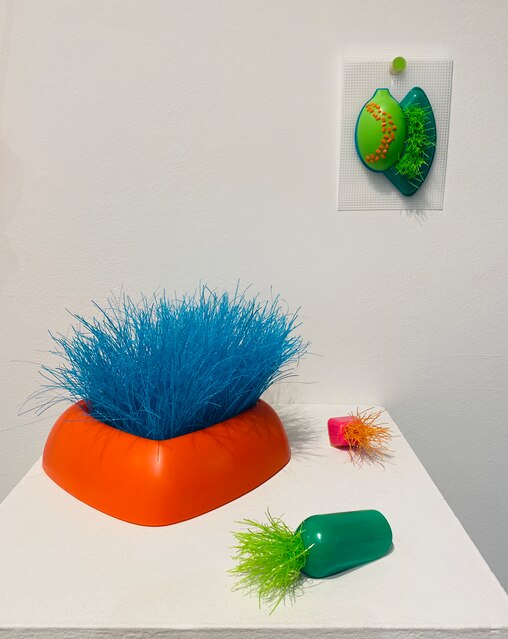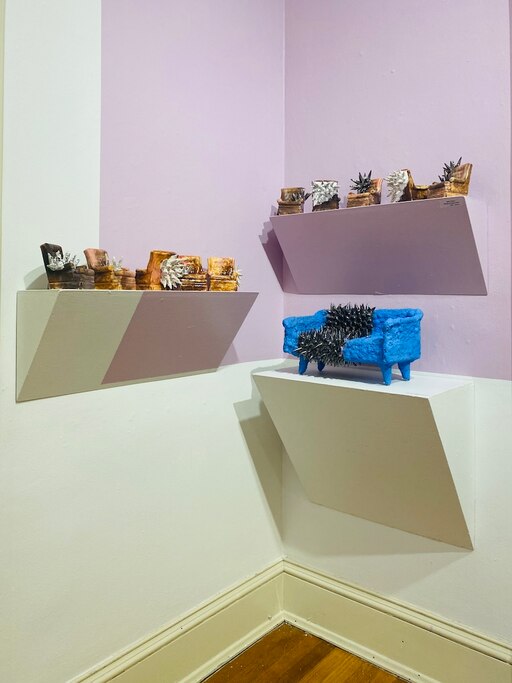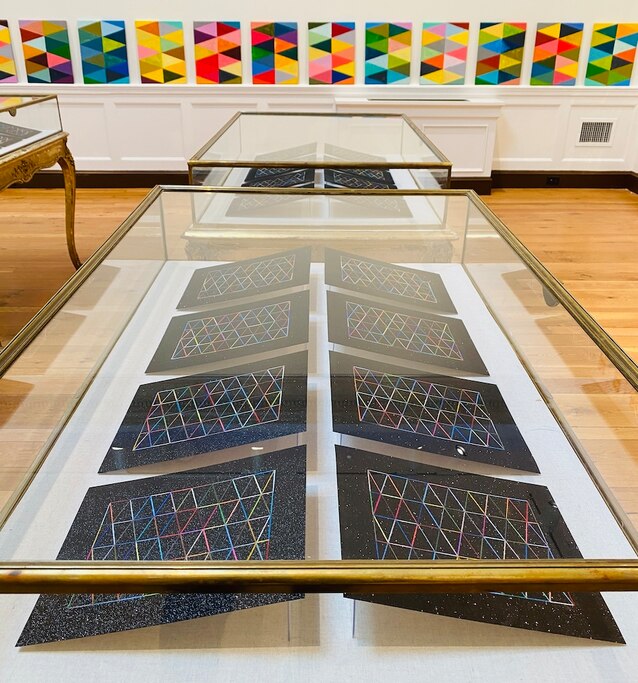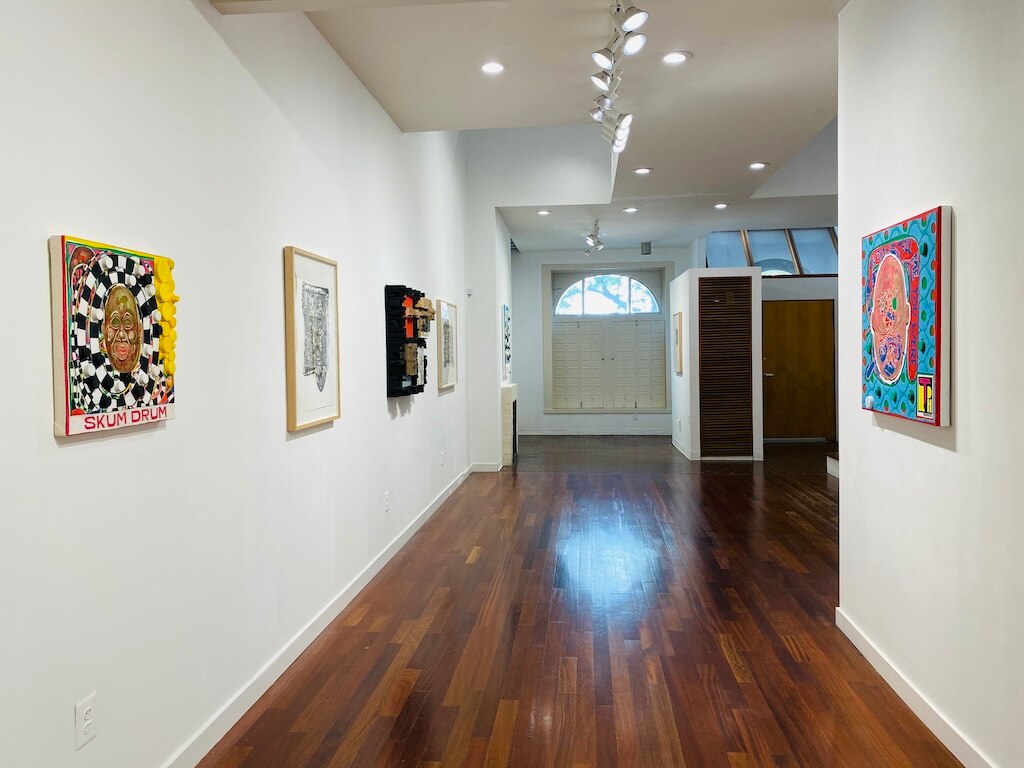This story is part of a partnership with The Baltimore Banner and BmoreArt that will provide monthly pieces focusing on the region’s artists, galleries and museums. For more stories like this, visit BmoreArt.com.
Materials are underrated in the art world. While gallery wall text tends to focus on an artist’s bio, politics, aesthetics or style, the reality is these can all alienate viewers — but materials offer kinship, beckoning with near universal appeal.
We all possess fond memories of finger painting, whittling wood, weaving and pinching clay pots. We all understand the essence of wool, copper, glass and rubber. We can all appreciate the delicacy of lace, the finality of concrete, the virtuosity of paint. The capacity to intrigue audiences of all ages, nationalities and backgrounds is a superpower; when materials are used in expert and unusual ways, they attract viewers directly, without fanfare or didactics.
Although materials offer an accessible approach to a work of art, they also possess the ability to radically change its meaning. Whole histories, ecologies and civilizations can be contained within a fragment of pottery or a scrap of fabric. The best artists harness the power of materials to extract embedded stories, lending an immediate complexity to their work. Whether artists conjure their materials into forms we have never seen before or build on an established tradition, a love affair with specific materials is the hallmark of a great artist.
The Baltimore Banner thanks its sponsors. Become one.
I encourage you to forgo the wall text and artist statements this month and focus directly on the beautiful complexity of materials, the ideas they conjure up and the stories they suggest. Here are four Baltimore-based exhibitions you can visit where artists explore their medium as a concept and a practice — an opportunity to experience their art without training wheels.
Katie Kameen, ‘RE: PLAY’
Baltimore Jewelry Center
10 E. North Ave., Suite 130, Baltimore
Through May 24


I really want to hate plastic. It’s the devil and possibly the end of the planet. But also: It’s so handy! It’s so breathable, so versatile, so compelling in texture and form. Even when cheaply mass-produced, plastic can be charming and complex. It’s literally everywhere, even inside us; microplastics can be found in our amniotic fluid, lungs and bloodstream. At this point, it’s probably changing our DNA, so we might as well embrace a relationship with plastic that includes healthy boundaries. Instead of ineffective recycling processes, why not make beautiful jewelry out of it?
Read More
On display at the Baltimore Jewelry Center gallery, Katie Kameen displays a vast and cheerful array of plastic rings and necklaces, earrings and brooches made entirely of secondhand, post-consumer plastic. Kameen’s series of rings and earrings based on children’s toys tempt us with bold color, intricate compositions and shiny surfaces. Each tiny assemblage resonates with a preppy and smart energy. Her second body of work is more disturbing — larger necklaces and sculptural works using functional household plastic in earthy colors that resemble organs and body parts, as well as the containers from hospitals used to clean and care for such parts. In both bodies of work, Kameen transforms familiar mass-produced trash into lovingly designed oddities, each a one-of-a-kind wearable sculpture that encapsulates our best and worst impulses and manages to be surprisingly beautiful.
Shea Kister, ‘all at the same time’
Baltimore Clayworks
5707 Smith Ave., Baltimore
Through May 25

Clay is perhaps the oldest and most accessible art material — you can literally dig it out of the ground and cook it over a fire. It can create useful household objects as well as realistic sculptural likenesses. It’s a medium that offers endless creative possibilities, and I suspect this is why every adult I know is currently taking clay classes. Although it’s not known for being a particularly humorous art medium, I think it’s really funny when artists make things out of clay that mimic materials that are the complete opposite. Mugs and vases are great, but a clay nose? A clay strawberry? A clay head or foot? A clay chain? Those are just so much cooler.
The Baltimore Banner thanks its sponsors. Become one.
Currently on display at Baltimore Clayworks: ceramic sculptures of tiny furniture being attacked and punctured by virus-like organisms. Shea Kister’s exhibit, “all at the same time,” is an intimate experience where the artist represents her emotions semi-abstractly, exploring the way she processes comfort and trauma simultaneously. Arranged in groups on faux fur-covered shelves and atop lavender wallpaper, Kister’s hand-built sculptures defy rational definition to emphasize conflict; you’re forced to focus on the physical attributes of clay as it varies in each sculpture. While her tiny couches and chairs — symbols of softness and rest — are smooth and, at times, glazed in metallics, the spiky virus shapes crackle with surface texture that suggests tension and viscerality, reminding us that even in spaces of respite there are countless other complex emotions surrounding us.
Ed Istwan, ‘FLOWERS’
The Peale Museum
225 Holliday St., Baltimore
Through June 2

“FLOWERS” at The Peale is the rarest of Instagram occurrences: When you spot an eye-catching image on your feed (an arty thirst trap?), and you decide to visit – and find it to be better in real life. As with dating apps, this is a magical unicorn.
The Baltimore Banner thanks its sponsors. Become one.
This solo exhibit features a multitude of art by Ed Istwan, a Baltimore-based artist who spent the last two decades as a visual merchandiser at IKEA. At The Peale, his decisive capabilities, obsession with repetitive mundane detail, and use of deceptively simple materials combine together to offer a potent visual alchemy. The show features over 300 individual works, but each is rendered in exactly the same composition: two vertical rows of eight triangles. What’s fascinating is that every composition offers a different array of colors, no hue is repeated twice in the same piece, and each is somehow balanced but different. It’s like climbing inside a Rubik’s Cube with thousands of colors that all blend harmoniously. The immersive scale makes this show a stunner, especially located in The Peale’s Latrobe Room, which boasts lofty walls, historic molding, and a giant skylight with gorgeous natural light that really makes the colors pop.
Scaled in groups of dozens and sometimes hundreds, Istwan’s tiny chromatic explorations are so simple that you cannot help but scrutinize them closely to parse out the minute differences between compositions. In some, the paper has been sourced from hardware paint samples and you catch a glimpse of text with the name of the color. Other squares bear subtle markings of a brush, hand-painted in an array of hues that would make the 100-plus Crayola pack jealous. Some compositions appear to be rainbow-hued line drawings, the same simple composition of two rows of vertical triangles, but in oil pastel on black sparkly sandpaper, or painted shapes on stretched burlap. They feel like the geometric cousins to Brice Marden, possessing a nonchalant elegance that references nature and crystallizes it into chromatic gems.
‘Material,’ Chakaia Booker, Leonardo Drew and Trenton Doyle Hancock; curated by Seph Rodney
Critical Path Method Gallery, also known as CPM
1512 Bolton St., Baltimore
Through June 22
The Baltimore Banner thanks its sponsors. Become one.

The Baltimore Banner thanks its sponsors. Become one.
What happens when a New York-based art critic guest-curates a show in Baltimore of three of his most esteemed colleagues? Material, the most accessible of art elements, becomes problematized, conceptualized and complicated in a way that requires wall text. I’m not mad at it, though. The show, aptly titled “Material,” is thoughtfully designed to emphasize each artist’s intentionally honed relationship with specific materials — a way to prioritize an essential aspect of their work that has historically been treated as secondary or tertiary in a gallery setting.
In his curatorial statement, Seph Rodney explains: “‘Material,’ as a noun refers to matter, stuff, the elemental parts of a thing. But as an adjective connotes that a thing is significant, consequential, weighty. My use of the homonym is for more than intellectual showmanship. Both of the ways in which the term operates are particularly germane to the artists I’ve placed in this exhibition — Chakaia Booker, Leonardo Drew, and Trenton Doyle Hancock — artists who utilize particular materials to make objects that are of substance, that is to say, meaningful.”
It’s significant that the curator and all three artists are Black, and though they are known globally for work that employs unusually specific materials, they are typically contextualized by identity, politics and social concerns. In “Material” at CPM, Booker, Drew and Hancock are all given space for quiet formal decisions and subtle material explorations to resonate. Stylistically, each artist is quite different from one another, but all have mastered their chosen medium over decades of experimentation. It’s a heady approach to materials, but also a way to make these mostly abstract works more approachable, emphasizing the gorgeous yet familiar aspects of embossed paper, Chine-collé, salvaged wood, paint and personal ephemera like pill bottles still emblazoned with drugstore text. Sure, this exhibit takes the most accessible aspect of art and complicates it, but in a way that emphasizes what the viewer has in common with each artist, rather than that which divides us.



Comments
Welcome to The Banner's subscriber-only commenting community. Please review our community guidelines.